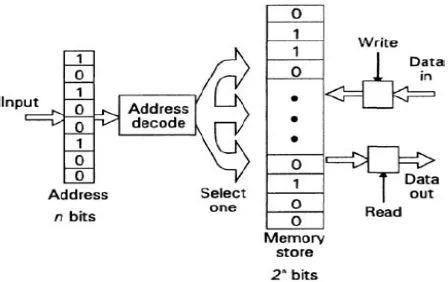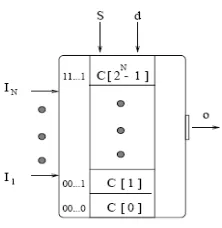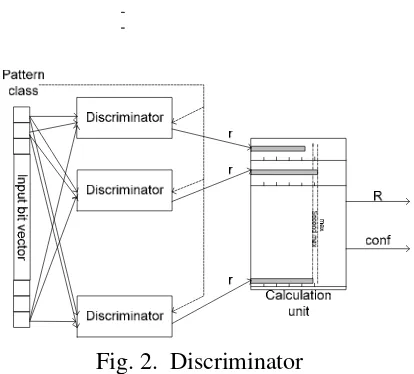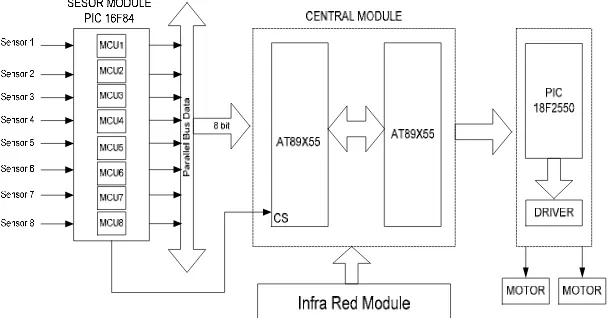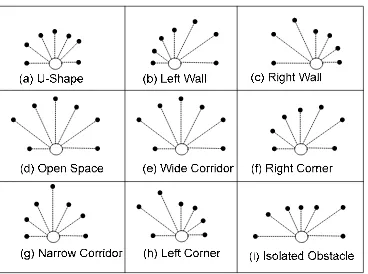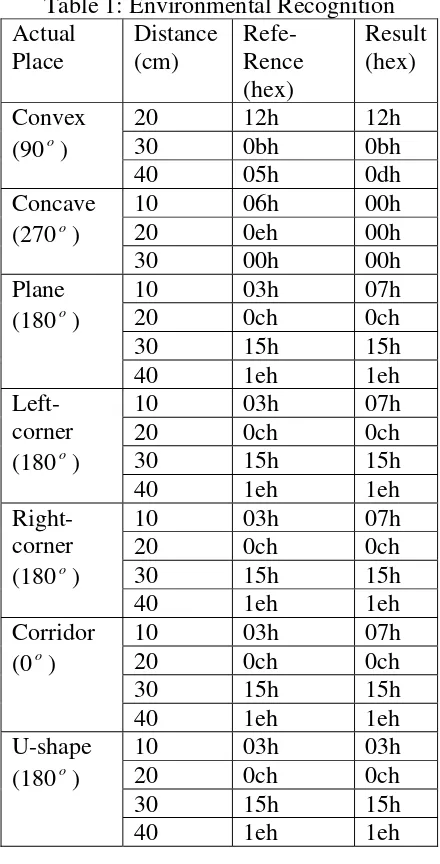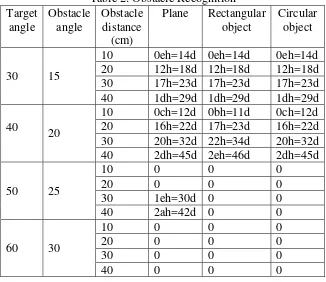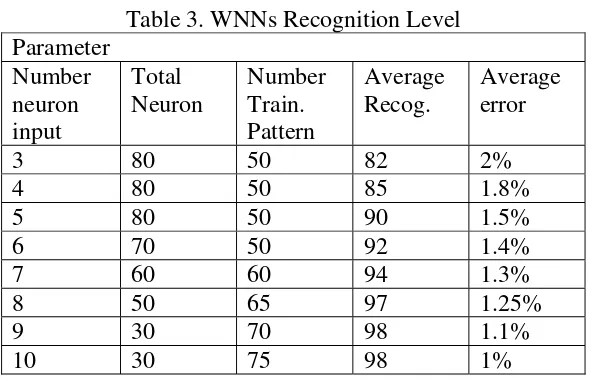Int. J. Advance. Soft Comput. Appl., Vol. 1, No. 1, July 2009 ISSN 2074-8523; Copyright © ICSRS Publication, 2009 www.i-csrs.org
Modular Weightless Neural Network
Architecture for Intelligent Navigation
Siti Nurmaini, Siti Zaiton Mohd Hashim, Dayang Norhayati Abang Jawawi
Faculty of Computer Science University of Sriwijaya
Indonesia
e-mail: [email protected]
Faculty of Computer Science and Information System Universiti Teknologi Malaysia
Skudai, Johor Bahru
e-mail: [email protected], [email protected]
Abstract
The standard multi layer perceptron neural network (MLPNN)
type has various drawbacks, one of which is training requires repeated presentation of training data, which often results in very long learning time. An alternative type of network, almost unique, is the Weightless Neural Network (WNNs) this is also called n-tuple networks or RAM based networks. In contrast to the weighted neural models, there are several one-shot learning algorithms for WNNs
where training takes only one epoch. This paper describes WNNs for
recognizes and classifies the environment in mobile robot using a simple microprocessor system. We use a look-up table to minimize the execution time, and that output stored into the robot RAM memory and becomes the current controller that drives the robot. This functionality is demonstrated on a mobile robot using a simple, 8 bit microcontroller with 512 bytes of RAM. The WNNs approach is code efficient only 500 bytes of source code, works well, and the robot was able to successfully recognize the obstacle in real time.
Keywords: Weightless neural network, environmental recognition,
1 Introduction
The neuron model used in the great majority of work involving neural networks is related to variations of the McCulloch-Pitts (1943) neuron, which will be called the weighted-sum-and-threshold neuron, or weighted neuron for short. The implementation of the network operation requires the use of multiplier unit, which can be problematic for embedded application due to the large size of resource because the training the generalized data required both the forward propagation phase and backward (back error) propagation phase. A typical weighted neuron specifies a linear weighted sum of the inputs, followed by some non-linear transfer function (I. Aleksander & H. Morton, 1995; T. B. Ludermir et al. 1999). The complexity of the training algorithm has limited its implementation in dedicated hardware. In contrast, the ANNs investigated are based on artificial neurons which often have binary inputs and outputs, and no adjustable weights between nodes. Neuron functions are stored in look-up tables that can be implemented using commercially available Random Access Memories (RAMs). Learning on these systems generally consists of changing the contents of look-up table entries, which results in highly flexible and fast learning algorithms. These systems and the nodes that they are composed of will be described respectively as Weightless Neural Networks (WNNs) and weightless nodes (I. Aleksander & H. Morton, 1995; T. B. Ludermir et al. 1999). They differ from other models, such as the weighted neural networks, whose training is accomplished by means of adjustments of weights. In the literature, the terms, “RAM-based” and “N-tuple based” have been used to refer to WNNs (R. Rohwer and M. Morciniec 1996; T. M. Jorgensen 1997; R. Al-Alawi 2007; P. Coraggio and M. De Gregorio 2007; C. Linneberg and T. M. Jrgensen 2006). In that approach supervised (Austin & Stonham, 1987; Filho et al. 1991; Gorse & Taylor 1991; Howells et al. 1995; Jorgersen et al. 1995) and unsupervised (Allison & Johnson 1989; Clarkson et al. 1991; de Carvalho et al. 1992; Ntourntoufis et al. 1990) learning techniques have been used with WNNs.
3 Modular Weightless Neural Network
needed to be raised whilst maintaining the generalization ability, along with the training speed and simple hardware implementation.
This work concerns development of efficient WNNs for classifies environment and recognize an obstacles in a mobile robot based on a simple microprocessor system. Some work done by others indicates this approach may be successful and effectiveness using WNNs in a number experimental studies in mobile robot (Mitchell et al. 1994; Silvia et al. 1996; Zhou et al. 1999; B. Osterloh, 2003; Yao et al. 2003; Zhang et al. 2005; Paolo C and M.D. Gregorio 2007; Simoes, E.D.V, 2008). They studies base on software implementation. However, that approach is limited by the amount of variable memory since RAM neurons are assembled as binary vector, addressed by the inputs and stored into system memory (L. Teresa 1999). If the number of inputs is high, what is very common in complex problems, each neuron will need a great amount of memory. This fact can make intractable the application of the RAM model in some cases with less available memory like microcontrollers. But the advantage of WNNs is their modularity. Modularity can be viewed as a manifestation of the principle of divide and conquer, which allows us to solve complex problems, by dividing them into smaller sub problems, easier to conquer, combining their individual solutions to achieve the final solution (Haussler, 1989). One of greater improvement achieved by this architecture is better generalization; the convention in neural networks is to use architecture as small as possible to obtain better generalization (A. Schmidt 1996).
One more important problem to solve in mobile robot research is self localization. It is often addressed as the first property to endow a robotic system to have high level reasoning capacity (Cox, I. J. 1991). The global position problem is the ability, for the robot, to autonomously recognize its pose starting from an unknown position on a given map (Borenstein, J. et al. 1996). It is a very difficult problem needing a lot of computational power, and giving not so much accurate results in terms of robot pose estimation (Thrun, S. 2005).
2 System Overview
This section describes the theoretical basis of the paper as well as the problem definition. Some basics about WNN systems are first presented.
2.1 The RAM Node
The basic architecture of RAM model is as follows, the input vector is divided into parts; each part is connected to the address inputs of a 1 bit-RAM unit. In a typical RAM network, that is single-layer architecture. This depicted in Figure 2 is a device which can store one bit of information for each input address. A control input is available to switch the mode of the RAM between ‘Write’ and ‘Read’ for learning and recall. Initially all memory units are set to ‘0’. During the learn (Write) mode the memory is set to ‘1’ for each supplied address; in the recall (Read) mode the output is returned for each supplied address, either ‘1’ (if the pattern was learned) or ‘0’ (if the pattern was not learned). RAMs are taught to respond with a 1 for those patterns in the training set and only for those patterns. An unseen pattern is classified in the same class of the training set if all RAMs output 1.
Fig. 2 RAM as Boolean function
In contrast to biologically motivated nodes, RAM nodes were initially designed as engineering tools to solve pattern recognition problems. An N input RAM node has 2N memory location, addressed by the N-bit vector a = {a1, a2, ….,aN}. A
5 Modular Weightless Neural Network
Fig. 1 Typical RAM node
Where,
N = connectivity; Ij= input terminal
C [I] = memory content; o = output terminal to transmit
d = input terminal to receive; s = learning strategy
2.2 The Discriminator
The basic element of discriminator is a bit addressable RAM discriminator that is
formed by a layer of K n-input RAMs, each one storing 2N one bit words. Although the input mapping is chosen at random, such a mapping is often fixed parameter of the network [L. Teresa et al. 1999; C. Linneberg and T. M. Jrgensen 2006]. This response vector can be regarded as a feature vector that measures the similarity of an input pattern to all classes.
In order to solve the problem of RAM-nodes having no generalization, several of these RAM-nodes can be combined to a so called discriminator. It consists of a layer of RAM-nodes organized as illustrated in Figure 2. The most important feature of a discriminator is that it splits the input pattern into K n-sized tuples, each of which are used as the input for a RAM-node. In this way the input pattern of the discriminator is distributed over the memory of several RAM-nodes, instead of being stored in only one location. The generalization is obtained from
introducing a summing device, denoted by the
∑
symbol. The function of this device is to sum up the outputs of all the RAM-nodes of that discriminator and divide it by the number of RAM-nodes K. This gives the fraction of RAM-nodes that generated a “1” when input vector X was given to the discriminator:) ( 1
1 X f K r
K
i ji
j
∑
=
Where
n= tuple size; K = number of RAM-nodes ; X = input vector
ji
f = output of RAM-node i belonging to the jthdiscriminator
i
x = the ith element of X; rj= the output of the jthdiscriminator
In this way the result r of the discriminator can be seen as the outcome of a membership function, it is a number between 0 and 1 which states how much pattern X resembles the pattern used in training set for discriminator. The set of feature vectors generated by the WNNs for a given training set will be used as input data to the fuzzy rule-based system. The normalized response of class j discriminator x is defined by: j
K r
xj = j (2)
The value of xj can be used as a measure of the similarity of the input pattern to
the jth class training patterns. The normalized response vector generated by all discriminators for an input pattern is given by:
x=[x1,x2,...,xN ], 0≤xj ≤1 (3)
This response vector can be regarded as a feature vector that measures the similarity of an input pattern to all classes. During the recalling, the system presents the input vector to all trained discriminator. The results rj of the
discriminators jthare passed to a calculation unit. This unit determines which discriminator gives the highest output. This is the class to which the input pattern is classified. It also calculates a measure of relative confidence C:
highest ondhighest highest
r r r
C= − sec (4)
7 Modular Weightless Neural Network
Fig. 2. Discriminator
3 The Robot Platform
Fig. 4. Architecture of modular system
The robot behaviors tested by eight sensors, and divided into four behaviors namely obstacle avoidance, left and right wall following, and emergency condition. The sensors position in all array are fixed: one on back sides, and seven facing outwards at 30o intervals starting from 1 -7. They report the distance between the robot and the closest obstacle. The placement of the sensors permits the detection of an obstacle in different positions. That configuration was very efficient during preliminary tests of robot navigation. Seven sensors positioned in the front of the robot, considering that the robot will be moving when it is maneuvering, there is no situation where a robot can approach an obstacle without seeing it. One sensor is placed in the back to allow the robot to detect emergency condition and the robot must be move backward or stop.
4 Modular WNNs Classifier Design
4.1 Sensor Classification
9 Modular Weightless Neural Network
Fig. 5. Sensor classification
4.2 Structure of Modular WNNs
The WNNs is designed to identify the current environment by recognizing typical patterns. To implement this network, the 8 bit data from eight ultrasonic sensors is used to determine the direction of the obstacle, in each direction an obstacle may or may not appear. The sensor module can enable or disable this 8-bit signal, preventing the sensor to be connected to the input lines. The combination of them appearance in the seven directions makes up different input pattern. In this experiment, a two- layer RAM base neural network was used, there are sensor layer and output layer, the structure is shown in Figure 6. The neural network used eight neurons for identifies where obstacle may lie in seven direction through ultrasonic sensor and seven output commands means that the neural network needs eight bits to encode them. Its configuration has seven groups of eight neurons (m=8 and n=7), so the network has 56 neurons.
The neurons s1 to sn are the binary sensor readings are connected in groups (discriminators) that correspond to one of the possible classes of commands (c1,c2,…, cn) the neural network can choose. The groups are connected to an
output adder (o1,o2,… ,on) that counts the number of active neurons in the group, there are seven position of obstacle in the robot environment such as, front, right, and left side of the mobile robot. A winner take all decision can be attached to the adder outputs to choose the discriminator containing the greater number of active neurons, pointing to the winning class.
[Filho, 1992]. If the network is having difficulty learning a different configuration, more neurons should be added. Different architecture was implemented until the developed solution was obtained.
Fig.6. Structure of WNNs
4.3 Generating Learning Strategy
In contrast to the weighted neural models, there are several one shot learning algorithms for WNNs, where training takes only one epoch. The learning of WNNs has no weight matrix, it directly changing the neuron contents in the look-up tables [5]. The procedures of learning/recalling process takes places by writing/reading into corresponding look up table entries. Initially all the contents are set to 0 and the learning of an input pattern is through the writing of the value 1 in the address content of the RAM neuron. During the recalling phase an input pattern is clamped to the network and all the neurons produce an output. The algorithm used to train is as follow.
• Initialize all location of the memory to a random binary [1,0] values and created the discriminator
• Defined recognition interval by the parameter 0≤ rmin ≤ rmax ≤ 1, rmaxbeing the maximum recognition
• Select an input pattern of the environment from sensor array • Access the RAM and generate an output,
11 Modular Weightless Neural Network
• Check value of recognition interval r, if rh ≤rmin , a new discriminator is created
• Check value of recognition interval r, if rmin ≤rh ≤rmax, it is assumed that the pattern to be performed is probabilistic selected
• Check value of recognition interval r, if rh ≤rmax, it is assumed that the pattern is already well represented the winning class of discriminator
• For all nodes, if r =1 then set input pattern to be learned, if r = 0, then clear all the nodes and reenter input pattern.
• Go to access the RAM
The algorithm requires repeated application of this process, until all nodes have learned the patterns.
5.
Experimental Result
5.1 Training with threshold
10 0eh=14d 0eh=14d 0eh=14d
20 12h=18d 12h=18d 12h=18d
30 17h=23d 17h=23d 17h=23d
40 1dh=29d 1dh=29d 1dh=29d
40
20
10 0ch=12d 0bh=11d 0ch=12d
20 16h=22d 17h=23d 16h=22d
30 20h=32d 22h=34d 20h=32d
40 2dh=45d 2eh=46d 2dh=45d
50 25
Table 3. WNNs Recognition Level
For some applications, where software approach is more flexible because it permit better integrations with other routines of the system. Then, the description of the RAM base neural network can be automatically translated into C language code. Consequently, the network can be directly executed into microprocessor ALU (Arithmetic Logic Unit). This fact decreases the execution time of the algorithm. The advantage of this technique is the employment of the microprocessor ALU to execute the logic operation set of the RAM algorithm. Simple logic functions are faster to execute than complex floating point operation, used by greater number of neural models. Table 4, show comparison the total processing time of software using C code and hardware implementation.
Type of Implementation in low cost
microcontroller
Source code Execution time
MLPNN in C language 30 Kbytes 5 ms
15 Modular Weightless Neural Network
6 Conclusion
Strategy has been developed which allows mobile robot to learn and move around an environment avoiding obstacles and this has been implemented in hardware. The operation of the complete controller that would take hundreds of lines of code to be implemented can be executed with one single instruction that reads the command byte in the memory. It can make the controller work hundreds of times faster. The controller is stimulated with every possible input and a corresponding output table is written. This output table is then stored into the robot RAM memory and becomes the current controller that drives the robot in the current environment. The network was implemented with very modes microcontroller system 20 Kbytes ROM, small amount of data memory about 256 bytes and 500 bytes source code program using combination in the microcontroller assembler and C code. The algorithm only 750 lines of program because . The result shows the mobile robot was able to detect and avoid obstacles in real time.
This work will continue with the development of an embedded real time learning system, implemented according to the same techniques that will make use of the WNNs one shot learning to quickly map the environment where the robot is moving. The application of the presented technique is not restricted to mobile robot application. It can be applied in industrial process, control process, and complex pattern recognition, that demands a high processing capacity.
The application of the presented technique is not restricted to mobile robot applications. It can be applied in complex pattern recognition problem that demands a high processing capacity.
7 Open Problem
The WNNs while fast learning algorithm, lacks generalization power. It is only recognizes previously learned tuple. To overcome this limitation, a set of neurons can be organized, where each neurons is responsible for the learning or recognition of a subset of an input pattern. The sub pattern assigned to each neuron is defined in a randomly created input-neuron mapping, which is used in both learning and recognition phases. Most of the WNNs configurations have the problem of poor growth of storage capacity with the size of the system. To solve this problem, ways to decompose system need to be considered.
ACKNOWLEDGEMENTS.
This work was supported by The Faculty of Computer Science, Sriwijaya University, Indonesia and Softcomputing Research Group, Faculty of Computer Science and Information System Universiti Teknologi Malaysia, Johor Bahru.
References
[1] A. de Carvalho, M.C. Fairhurst and D.L. Bisset. “SOFT – A boolean self organizing feature extractor”. In I. Aleksander and J.G. Taylor , editors, Proceedings of the International Conference on Artificial Neural Network, pp 669-672, Brighton, UK, Sepetember, 1992.
[2] Botelho, S. C., Simoes, E. D. V., Uebel, L. F., and Barone, D. A. C., “High Speed Neural Control for Robot Navigation”. Proceedings of the IEEE International Conference on Systems, Man and Cybernetics, Beijing, China, pp. 421-429, 1996.
[3] Borenstein, J., Everett, H.R., Feng, L. “Navigating Mobile Robots: Systems and Techniques”, A. K. Peters, Ltd., Natick, MA, USA, 1996.
[4] C. Linneberg and T. M. Jrgensen. “N-tuple or RAM based neural network classification system and method”. United States Patent 6999950, 2006.
[5] Cox, I.J. “Blanche-an experiment in guidance and navigation of an autonomous robot vehicle”. Robotics and Automation, IEEE Trans. on 7 pp. 193–204, 1991.
[6] E.Filho, M.C.Fairhurst and D.L.Bisset “Adaptive pattern recognition using goal-seeking neurons”, Pattern Recognition Letters, v.12, 131-138, march 1991.
[7] I. Aleksander, W. V. Thomas, P. A. Bowden, ”Wisard: A radical step forward in image recognition.” Sensor Review, pp 120-124, July 1984.
[8] I. Aleksander and H. Morton. “An introduction to neural computing”. Chapman and Hall, London, U.K., 2 edition, 1995.
[9] I. Aleksander and H. Morton. “General neural unit: retrieval performance”. IEE Electronics Letters, 27:1776-1778, 1991.
[10] J, Austin, “A Review of RAM-Based Neural Networks”. Proceedings of the Fourth International Conference on - MICRONEURO94, pp. 58-66,1994.
[11] J.Austin and T. J. Stonham, “An associative memory for use in image recognition and occlusion analysis”, Image and Vision Computing, v. 5, pp. 251-261, 1987.
17 Modular Weightless Neural Network
[13] M. Keat et al.. “Weightless neural network array for protein classification”. In PDCAT, volume 3320 of LNCS, pages 168–171. Springer, 2004.
[14] N.M. Allison and M.J. Jhonson, “ Realisation of Self Organizing Neural Maps in {0,1} space. In J.G. Taylor and C.L.T. Mannion, editors, New Development in Neural Computing.
[15] P. Coraggio and M. De Gregorio. “WiSARD and NSP for Robot Global Localization” In Proc. of the IWINAC, LNCS, volume 4528, pages 449– 458, 2007. Springer-Verlag.
[16] Q. Yao, D. Beetner, D.C. Wunsch, and B. Osterloh., “A RAM-Based Neural Network for Collision Avoidance in a Mobile Robot”, IEEE, 2003.
[17] R. Al-Alawi, “FPGA Implementation of a Pyramidal Weightless Neural Networks Learning System” International Journal of Neural Systems, Vol. 13, No. 4, pp.225-237, 2003.
[18] R. Al-Alawi. “Performance evaluation of fuzzy single layer weightless neural network”. Int. J. of Uncertainty, Fuzziness and Knowlege-Based Systems, 15(3):381–393, 2007.
[19] R. J. Mitchell, D. A. Keating, and C. Kambhampati, “Neural network controller for mobile robot insect,” Internal report, Department of Cybemetics, University of Reading, April 1994.
[20] R. Rohwer and M. Morciniec. “A theoretical and experimental account of n-tuple classifier performance”. Neural Computation, 8(3):629–642, 1996
[21] Simoes, E.D.V., “An Embedded Evolutionary Controller to Navigate a Population of Autonomous Robots”, Frontiers in Evolutionary Robotics, I-Tech Education and Publishing, Vienna, Austria Book edited , ISBN 978-3-902613-19-6, pp. 596, April 2008.
[22] Simoes, E. D. V., Uebel, L. F., and Barone, D. A. C., “Hardware Implementation of RAM Neural Networks”. In Pattern Recognition Letters, n. 17, pp. 421-429, 1996.
[23] S. Ramanan, R.S. Petersen, T.G.Clarkson and J.G.Taylor “ pRAM nets for detection of small targets in sequence of infra-red images”, Neural Networks, pages 1227-1237, 1995.
[24] T. B. Ludermir et al. “Weightless neural models: A review of current and past works”. Neural Computing Surveys, 2:41–61, 1999.
[25] T. M. Jorgensen. “Classification of handwritten digits using a RAM neural net architecture”. Int. J. of Neural Systems, 8(1):17–25, 1997.
[27] T. G. Clarkson et al.,“Speaker Identification for Security Systems Using Reinforcement-Trained pRAM Neural Network Architectures,” IEEE Transaction On Systems, Man and Cybernatics-Part C: Application and Reviews, Vol. 31, No. 1, pp. 65-76, Feb. 2001.
[28] Thrun, S., Burgard, W., Fox, D.: Probabilistic Robotics (Intelligent Robotics and Autonomous Agents). The MIT Press, 2005.
[29] W. S. McCulloch and W. Pitts. A logical calculus of the ideas immanent in nervous activity. Bulletin of Math. Biophysics, 5:115–137, 1948.
